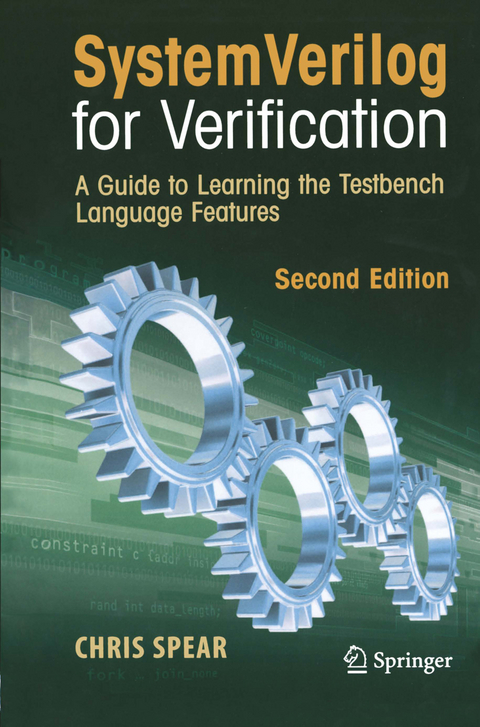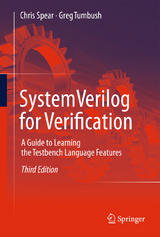
SystemVerilog for Verification
Springer-Verlag New York Inc.
978-1-4419-4561-7 (ISBN)
- Titel erscheint in neuer Auflage
- Artikel merken
SystemVerilog for Verification, Second Edition provides practical information for hardware and software engineers using the SystemVerilog language to verify electronic designs. The author explains methodology concepts for constructing testbenches that are modular and reusable. The book includes extensive coverage of the SystemVerilog 3.1a constructs such as classes, program blocks, randomization, assertions, and functional coverage. It also reviews SystemVerilog 3.0 topics such as interfaces and data types.
This second edition contains a new chapter that covers programs and interfaces as well as chapters with updated information on directed testbench and OOP, layered, and random testbench for an ATM switch. This edition also includes a new chapter that covers “Interfacing to C” and many new and improved examples and explanations.
For hardware engineers, the book has several chapters with detailed explanations of Object Oriented Programming based on years of teaching OOP to hundreds of students. For software engineers, there is a wealth of information on testbenches, multithreaded code, and interfacing to hardware designs. The reader only needs to know the Verilog 1995 standard.
"The complete book that covers verification concepts and use of system verilog in Verification, taking your from an easy start to advanced concepts with ease.
Paul D. Franzon, Alumni Distinguished Professor of ECE, North Carolina State University"
1. Verification Guidelines.- 1.1 The Verification Process.- 1.2 The Verification Methodology Manual.- 1.3 Basic Testbench Functionality.- 1.4 Directed Testing.- 1.5 Methodology Basics.- 1.6 Constrained-Random Stimulus.- 1.7 What Should You Randomize?.- 1.8 Functional Coverage.- 1.9 Testbench Components.- 1.10 Layered Testbench.- 1.11 Building a Layered Testbench.- 1.12 Simulation Environment Phases.- 1.13 Maximum Code Reuse.- 1.14 Testbench Performance.- 1.15 Conclusion.- 2. Data Types.- 2.1 Built-in Data Types.- 2.2 Fixed-Size Arrays.- 2.3 Dynamic Arrays.- 2.4 Queues.- 2.5 Associative Arrays.- 2.6 Linked Lists.- 2.7 Array Methods.- 2.8 Choosing a Storage Type.- 2.9 Creating New Types with typedef.- 2.10 Creating User-Defined Structures.- 2.11 Type conversion.- 2.12 Enumerated Types.- 2.13 Constants.- 2.14 Strings.- 2.15 Expression Width.- 2.16 Conclusion.- 3. Procedural Statements and Routines.- 3.1 Procedural Statements.- 3.2 Tasks, Functions, and Void Functions.- 3.3 Task and Function Overview.- 3.4 Routine Arguments.- 3.5 Returning from a Routine.- 3.6 Local Data Storage.- 3.7 Time Values.- 3.8 Conclusion.- 4. Connecting The Testbench and Design.- 4.1 Separating the Testbench and Design.- 4.2 The Interface Construct.- 4.3 Stimulus Timing.- 4.4 Interface Driving and Sampling.- 4.5 Connecting It All Together.- 4.6 Top-Level Scope.- 4.7 Program — Module Interactions.- 4.8 SystemVerilog Assertions.- 4.9 The Four-Port ATM Router.- 4.10 The ref Port Direction.- 4.11 The End of Simulation.- 4.12 Directed Test for the LC3 Fetch Block.- 4.13 Conclusion.- 5. Basic Oop.- 5.1 Introduction.- 5.2 Think of Nouns, not Verbs.- 5.3 Your First Class.- 5.4 Where to Define a Class.- 5.5 OOP Terminology.- 5.6 Creating New Objects.- 5.7 Object Deallocation.- 5.8 Using Objects.- 5.9Static Variables vs. Global Variables.- 5.10 Class Methods.- 5.11 Defining Methods Outside of the Class.- 5.12 Scoping Rules.- 5.13 Using One Class Inside Another.- 5.14 Understanding Dynamic Objects.- 5.15 Copying Objects.- 5.16 Public vs. Local.- 5.17 Straying Off Course.- 5.18 Building a Testbench.- 5.19 Conclusion.- 6. Randomization.- 6.1 Introduction.- 6.2 What to Randomize.- 6.3 Randomization in SystemVerilog.- 6.4 Constraint Details.- 6.5 Solution Probabilities.- 6.6 Controlling Multiple Constraint Blocks.- 6.7 Valid Constraints.- 6.8 In-line Constraints.- 6.9 The pre_randomize and post_randomize Functions.- 6.10 Random Number Functions.- 6.11 Constraints Tips and Techniques.- 6.12 Common Randomization Problems.- 6.13 Iterative and Array Constraints.- 6.14 Atomic Stimulus Generation vs. Scenario Generation.- 6.15 Random Control.- 6.16 Random Number Generators.- 6.17 Random Device Configuration.- 6.18 Conclusion.- 7. Threads and Interprocess Communication.- 7.1 Working with Threads.- 7.2 Disabling Threads.- 7.3 Interprocess Communication.- 7.4 Events.- 7.5 Semaphores.- 7.6 Mailboxes.- 7..- 7.7 Building a Testbench with Threads and IPC.- 7.8 Conclusion.- 8. Advanced Oop and Testbench Guidelines.- 8.1 Introduction to Inheritance.- 8.2 Blueprint Pattern.- 8.3 Downcasting and Virtual Methods.- 8.4 Composition, Inheritance, and Alternatives.- 8.5 Copying an Object.- 8.6 Abstract Classes and Pure Virtual Methods.- 8.7 Callbacks.- 8.8 Parameterized Classes.- 8.9 Conclusion.- 9. Functional Coverage.- 9.1 Coverage Types.- 9.2 Functional Coverage Strategies.- 9.3 Simple Functional Coverage Example.- 9.4 Anatomy of a Cover Group.- 9.5 Triggering a Cover Group.- 9.6 Data Sampling.- 9.7 Cross Coverage.- 9.8 Generic Cover Groups.- 9.9 Coverage Options.- 9.10 Analyzing CoverageData.- 9.11 Measuring Coverage Statistics During Simulation.- 9.12 Conclusion.- 10. Advanced Interfaces.- 10.1 Virtual Interfaces with the ATM Router.- 10.2 Connecting to Multiple Design Configurations.- 10.3 Procedural Code in an Interface.- 10.4 Conclusion.- 11. A Complete Systemverilog Testbench.- 11.1 Design Blocks.- 11.2 Testbench Blocks.- 11.3 Alternate Tests.- 11.4 Conclusion.- 12. Interfacing With C.- 12.1 Passing Simple Values.- 12.2 Connecting to a Simple C Routine.- 12.3 Connecting to C++.- 12.4 Simple Array Sharing.- 12.5 Open arrays.- 12.6 Sharing Composite Types.- 12.7 Pure and Context Imported Methods.- 12.8 Communicating from C to System Verilog.- 12.9 Connecting Other Languages.- 12.10 Conclusion.- References.
| Erscheint lt. Verlag | 5.11.2010 |
|---|---|
| Zusatzinfo | 5 Illustrations, black and white; XXXVI, 429 p. 5 illus. |
| Verlagsort | New York, NY |
| Sprache | englisch |
| Maße | 155 x 235 mm |
| Themenwelt | Mathematik / Informatik ► Informatik ► Theorie / Studium |
| Informatik ► Weitere Themen ► CAD-Programme | |
| Informatik ► Weitere Themen ► Hardware | |
| Technik ► Elektrotechnik / Energietechnik | |
| ISBN-10 | 1-4419-4561-X / 144194561X |
| ISBN-13 | 978-1-4419-4561-7 / 9781441945617 |
| Zustand | Neuware |
| Haben Sie eine Frage zum Produkt? |
aus dem Bereich



